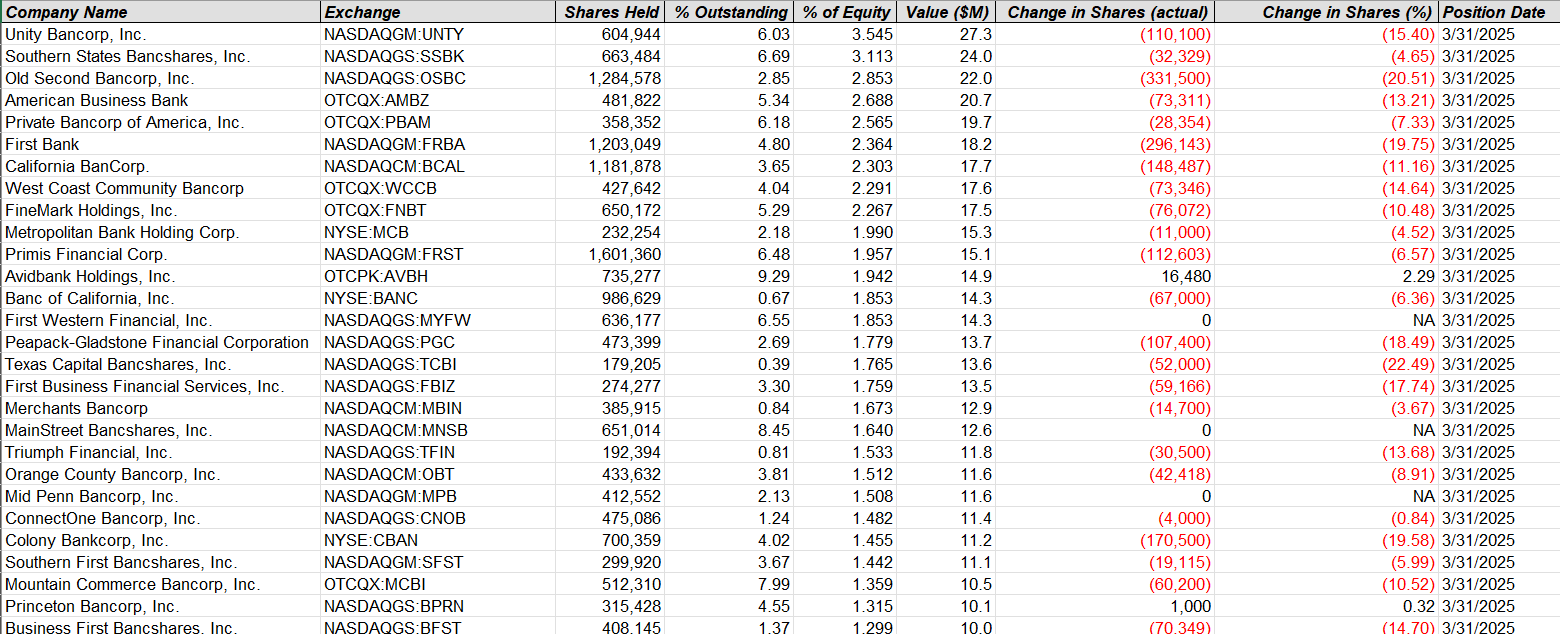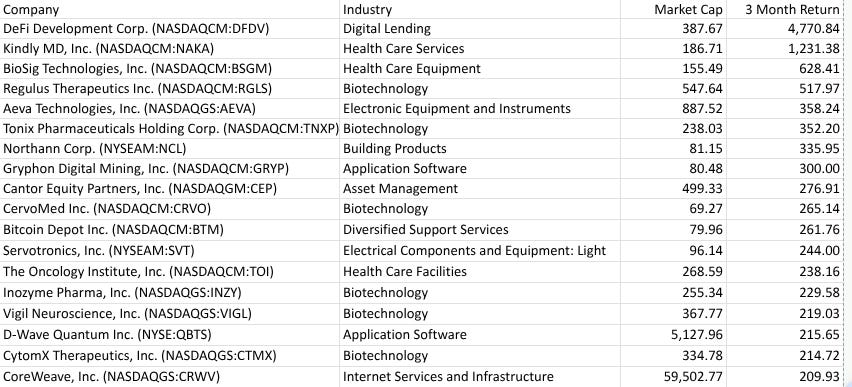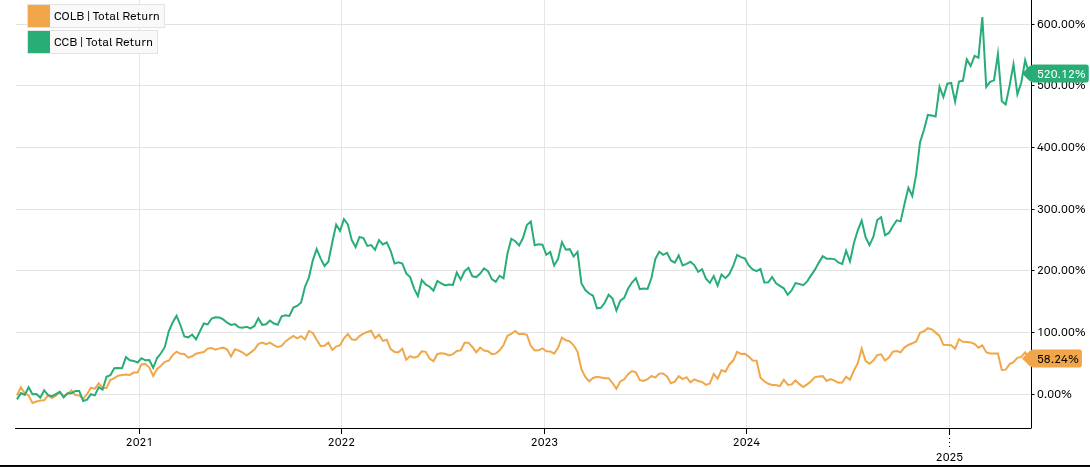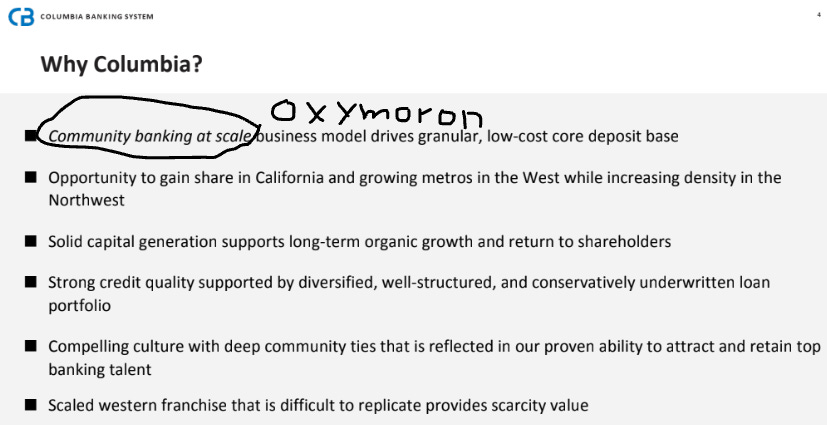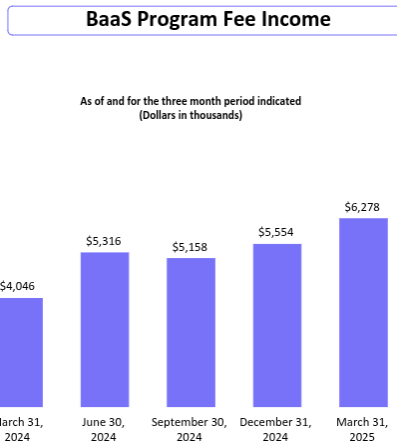June: Looking for Fraud
New Lessons at Janover, now up closer to 3000%; Banks can have moats, and some are actually widening; Looking at the F word around a Florida bank, DAVE de-regulation and the next multi-bagger
In this note:
Brief Notes: Banc Funds, come back!
The 5 Points:
The Janover Lesson reconsidered: A new sector in the financials universe is born, where some teams create more value than others.
Banks growing moat. Every bank has a “moat” - their below-market cost of funds. Some have broader moats than others. We looks at pairs of banks - those growing moat vs those losing it:
CBNK / UBSI
NBHC / UMBF
CCB / COLB
Is the “F word” justified at NewtekOne (NEWT)?
Deregulation, DAVE and searching for the next multi-bagger
5 Points is 4 points this month because I could not come to a conclusion on SOFI after 2 weeks of work. I hope to conclude next month.
Next month:
- A review of private credit’s golden age shows tarnish forming;
- How will AI affect the investment process in small and microcap financials?
- Possibly, a note on SOFI beat and raise potential despite operating a business where few can earn their cost of capital even in good times (unsecured consumer)
Brief notes:
Banc Funds, Banc Funds…Come Back!
I would call it “Banc Funds, Don’t Go” but the little boy in the movie Shane says “come back!”.
For as long as I have been investing in banks, Banc Funds, an institutional investor in small banks out of Chicago, has been large, patient investment capital in small, consolidating banks. Below is a bit about the company:
Yet today we can be excused for wondering if Banc Funds, which has diversified into fintech and rebranded itself “1st and Main Growth Investors” is liquidating its bank investments:
We saw this filing in 4Q:
and the selling continued in the first quarter:
We sometimes joke that today, the number of investors committed to bank sector investing can fit in a phone booth. A few years ago I wrote a “Last of the Mohicans” segment about the vanishing financials sector active manager.
With a liquidating large fund therefore it would be helpful to see bank buybacks in place for many of these positions to offset price impact. However that’s only the case in a few situations above (AMBZ for example). At least there are several thousand folks reading this note to possibly give it a go.
Further, the fund seems to be taking a patient approach to divestiture.
Regardless of the timeline, it will be a sad day if and when Banc Funds moves on, and their long-term approach will be missed.
And why are we here? I have not seen Banc Funds’ returns, and many principals must be near retirement, but I do know that until Bessent and Bowman get going with meaningful de-regulation, it’s challenging to hold a long list of spread banks and make good money compared to the Mag7. In my view bank investors do well to hunt with a rifle rather than a shotgun, own compounders, and impatiently cull lower-quality banks that take too long to sell.
1) Defi Development (DFDV, formerly Janover) follow up lessons: we have a new sector to track, with wide variations in returns and quality.
Last month I tried to make sense of a strange situation in markets; a stock I backed into rose 800% in a month (DFDV).
I effectively wrote that crypto was here to stay, had more institutional support than many understood, and gave credit to the company’s founder for selling.
Since then 800% became 3000% and other lessons emerged:
In any sector, the best operators get the best multiple, and that should also be the case here.
Many will follow.
Near term may bring downside.
This is a new asset class, a bit like how mortgage REITs evolved around agency bonds.
To be clear, I invest little if any in these types of companies, and the best levered magic bean companies are still in the business of magic beans. But I’m pleased to have another financial subsector to study, especially because for better or worse unlike banks, some of the country’s best engineering minds are attracted to crypto.
So, first lesson:
a) Some will do it better than others.
Suppose you wanted to avoid US dollars and went looking for a replacement in crypto. Would you prefer to invest in a company like this?:
Or one like this? (click the link at left for detail):
My personal opinion is the Trump effort is a “that sounds good, how much money can I make out of it” scheme while the Kraken people running DFDV are experienced in improving risk / reward with a targeted asset.
Admittedly there is limited differentiation inside this emerging sector but if you at least take the time to learn the difference between Solana validation and Bitcoin mining you might agree with me that thoughtful operators can add substantial value.
Many will follow.
Below is a list of Nasdaq companies over $50mln market cap by returns over the last 3 months as of Wednesday:
The #2 spot, KindlyMD, offers compassionate, evidence-based medication management. Just kidding - that was Monday; they are now in on Bitcoin leverage:
If all you have to do to see elevated returns is find some institutional partners, many of whom are getting rich, and start buying Bitcoin with a convertible bond, this trend will ramp until it hits a wall. It may also rescue several tiny Nasdaq shell companies.
Defi Development stock may see downside.
DFDV trades at 3x+ the value of the Solana it owns. Nobody will sustainably pay 3 Solana to own 1 Solana, so in order to make the model work, the company will need to issue more shares or bonds at an accretive price, like right here. That issuance will affect supply vs demand per Econ 101, particularly given shorts are very interested in locates, which currently cost about 200% at Interactive Brokers.
If management does it correctly, they will issue shares or a convert, but sustain a premium to the value of the underlying Solana. They will validate, no pun intended, their model by generating returns well above what people can make owning Solana on Coinbase, and Coinbase customers will sell their Solana and buy DFDV instead.
This is a new asset class, which we could compare to mortgage REITs.
Would you rather own an agency bond yielding 4%, or a mortgage REIT leveraging agency bonds yielding 9%? Crypto treasury companies are a similar situation and like a Surtsey island are creating a sector in front of us.
Crypto treasury companies won’t pay as much direct yield as REITs, and they won’t get margin called to $2 every 8-10 years as some mortgage REITs do. As mentioned some will stand out, and over time they should settle into a role as less volatile financial engineering companies at modest premiums or discounts to their underlying holdings.
We should continue to see fantastic volatility as this sector emerges, until the inevitable shakeout and maturity in the months and years ahead.
2) Banks can have a moat. A look at three that are widening and three shrinking.
I recently came across an investing checklist that focused on buying widening moats and selling shrinking moats. This is a bedrock concept to generalist investing but one that gets overlooked in the bank sector.
That’s because the average portfolio manager will tell you banks have no moat - banks sell money and compete on price. For example a few years back Ron Shevlin, a thoughtful Fintech writer, argued that among banks only USAA has a moat.
However banking moats should not be overlooked. If we measure moats by ROIC like Maubussin does here, then the no moat thesis is false for three reasons.
First, banks’ low cost of funds is an advantage in itself. Nobody gives up money at 2% except to a bank. Second, no other bank seems to be able to replicate what highly profitable small banks like Coastal Bank and Esquire are doing, or even come close. Third, moats are everywhere if you look - from Amalgamated’s (AMAL) union deposits to Metrocity’s (MCBS) Korean affinity brand to Wells Fargo’s treasury management technology, any good bank has some level of distinction vs the market.
Most importantly, there are banks that sustainably earn above their cost of capital. I write about them every month.
So in this note we look briefly at three “growers” and “shrinkers.” A common theme is the shrinkers are adding spread assets through acquisition while the growers are spending on technology and finding scalable niches.
Capital Bank (CBNK) vs United (UBSI) on the Atlantic coast
National Bank (NBHC) vs United Missouri (UMBF) in the Midwest
Coastal (CCB) vs Columbia (COLB) in the Northwest
Capital vs United:
Capital’s CEO, who has been interviewed in 5 Points, looks for differentiating businesses. These include PAC deposits, USDA lending, and stored value cards, all of which are arguably superior return businesses than typical retail banking.
Banks shy from niches like these because they involve a lot of hard work and planning, but CBNK printed a 1.7% ROA in 1Q, near the best in the sector.
United looks to expand its retail banking business through acquisition. However as Servisfirst CEO Broughton tells us, “If you do enough acquisitions, over time you become average.” UBSI 1Q ROA was 1.07%.
There’s more to it, but not a lot more and it’s reasonable to expect CBNK to expand its lead in total return over UBSI in the quarters and years ahead so long as these strategies remain in place.
Let’s switch to a trickier one:
National (NBHC) vs United Missouri (UMBF)
NBHC is the “grower” but UMBF has outperformed.
NBHC is the grower because they are working on two scalable projects, Cambr and 2Unifi. While both efforts are early stage and could fail, they are pushing NBHC is the direction of collecting fees on scalable technology. Cambr in particular has the potential to challenge the best business in banking - pooled deposit guarantees - if they can manage around the Intrafi patents. These deposit guarantees are almost pure profit and reportedly generate $400 million in annual income for Intrafi’s private equity owners.
In contrast UMBF will be integrating a $19bn deal that helps some on wealth but mostly brings spread, diluting UMB’s funds administration business and taking fees from 38% of revenues to 29% in 1Q. UMBF does gets “scale”, but is that another word for “trying to win auctions against US Bank and Fifth Third for $50mln credits”? That is the definition of a no moat business.
Most banks with $70bn in assets are in purgatory, too small to compete with G-SIFI banks on technology but too large to compete with small banks on making decisions. Their best option may ultimately be sale to PNC if they can’t find differentiation.
Next, a Globetrotters vs Washington Generals matchup in the Pacific Northwest:
Coastal (CCB) vs Columbia (COLB)
Columbia and Umpqua merged in 2023. Admittedly, moat at both was shallow to begin with but today it may be dry as the combined $52bn asset entity has not been able to grow EPS, loans or return on assets.
Looking at COLB financials below I am reminded of the Anton Chigurh question in No Country For Old Men: “If the rule that you followed brought you to this, of what use was the rule?
The 2023 merger timeline is represented above by the red numbers in 1Q23.
While Columbia struggles to generate value post merger, Coastal is organically onboarding large non-bank partners that it anticipates could each generate over $5 million pretax. Ironically, Coastal’s partnership banking allows new entrants like T Mobile and Wal Mart to further take share from the commoditizers, by offering commoditized products on top of existing broad distribution.
Call it BaaS, or rent-a-bank. Either way Coastal was an early mover and has now mastered the concept of having investment-grade S&P 500 customers take credit risk rather than Coastal. Coastal still pockets a 5%+ net interest margin. Coastal also earns $6 million a quarter of transactional fee income that may grow close to $1mln a quarter in 2025.
Granted, Coastal’s ROE has recently fluctuated between 10-18%, because of compliance expense to onboard massive partners to scale these fee revenues. Key employee Brian Hamilton’s team is working to automate some of this expense and the bank did an impressive job quickly onboarding T Mobile’s T Money offering in earely April.
Next time you look at a bank investment, I’d encourage you to incorporate the moat heuristic into your process.




